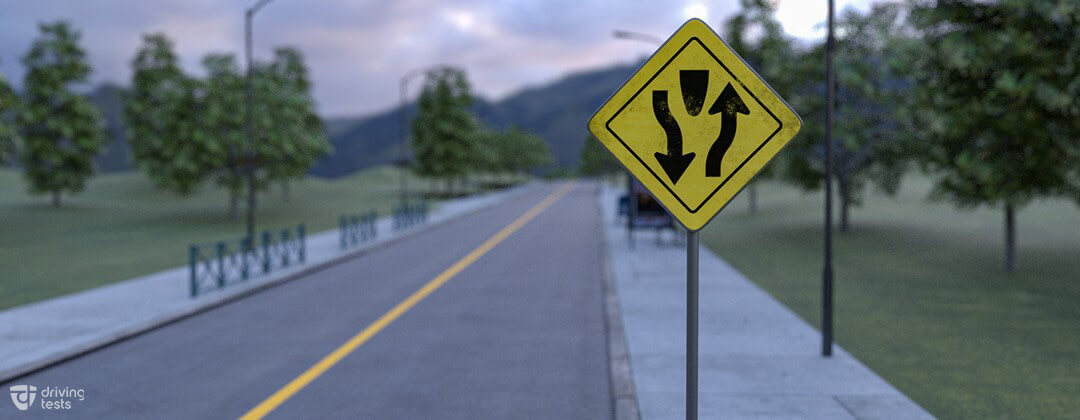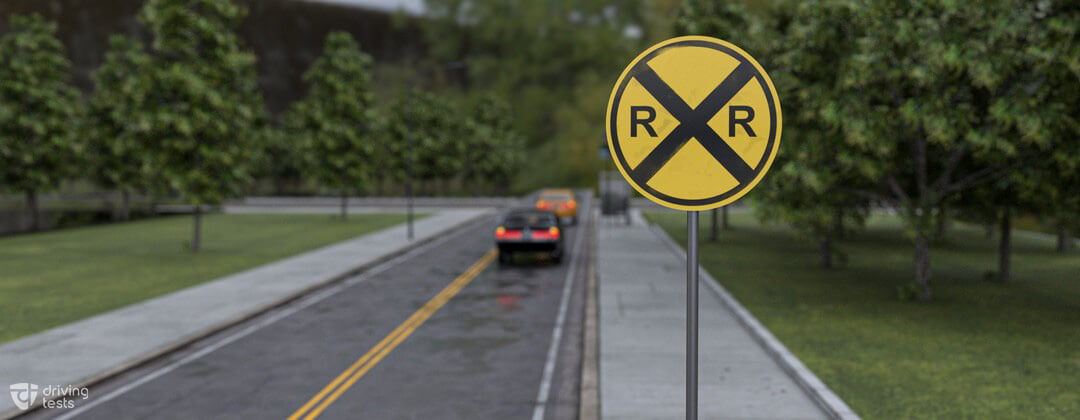You pulled up to a 4-way Stop sign at the same time as another driver to your right. Who gets to turn first?
The other driver (car to the right has the right of way)
If your vehicle has stalled on railroad tracks and you know that a train is approaching, you must
A. shift into neutral and try to push the vehicle off the tracks.
B. keep trying to start the engine. Then drive your vehicle off the tracks.
C. get yourself and all passengers out of your vehicle and get as far away from the tracks as possible.
D. roll down your window and open your doors.
C. get yourself and all passengers out of your vehicle and get as far away from the tracks as possible.
First speeding offense for a JOL driver with a permit requires ________.
A. A 90 day suspension of the permit, retaking and passing the License Knowledge Exam, and a $100 reinstatement fee.
B. A one-year permit suspension, retaking and passing the License Knowledge Exam, and a $500 reinstatement fee.
C. Payment of the speeding violation.
D. Suspension of the permit until the person turns 18 years of age.
A. A 90 day suspension of the permit, retaking and passing the License Knowledge Exam, and a $100 reinstatement fee.
If you are ever pulled over by the police, you should do this with your hands.
Keep them on the steering wheel until officer asks for your license and registration.

A flashing yellow means ...
To must stop if it is safe to do so
On a highway, you should pass other cars in these two lanes.
The middle or left lanes
The danger areas around your vehicle where crashes are more likely to occur are called
A. Round spots
B. Empty spots
C. Blind spots
D. No-passing zones
C. Blind spots
A conviction of using a false or altered license will result in a license suspension of ____ days.
A. 60
B. 90
C. 180
D. 365
c. 180 days
When passing a stopped emergency vehicle with flashing lights, you must
A. continue at the same speed and move into a non-adjacent lane.
B. slow down and move into a non-adjacent lane.
C. increase your speed and change lanes.
D. stop and move toward the right edge of the roadway.
B. slow down and move into a non-adjacent lane.
What does this sign indicate?
A. You must go straight.
B. You may go straight or turn left.
C. You must make a right turn.
D. You may go straight or turn right.
D. You may go straight or turn right.
When you find both a solid and a broken yellow line between opposing lanes of traffic, you must NOT pass ...
A. if the broken yellow line is on your side.
B. if the solid yellow line is not on your side.
C. at all.
D. if the solid yellow line is on your side.
D. if the solid yellow line is on your side.
If your rear wheels start to skid, you must
A. turn the steering wheel toward the left.
B. turn the steering wheel in the direction of the skid.
C. turn the steering wheel in the opposite direction of the skid.
D. turn the steering wheel toward the right.
B. turn the steering wheel in the direction of the skid.
To avoid a head-on collision when you see an oncoming vehicle in your lane, you must
A. increase your speed.
B. steer left toward the median.
C. steer right toward the shoulder or curbline.
D. keep your steering wheel straight.
C. steer right toward the shoulder or curbline.
If you are in an intersection and hear the siren of an emergency vehicle, you should
A. continue through the intersection, then pull over to the right and stop.
B. move to the left and stop in the intersection.
C. move to the right and stop in the intersection.
D. continue through the intersection, then pull over to the left and stop.
A. continue through the intersection, then pull over to the right and stop.
Work zone or construction zone signs usually have
A. white letters on an orange background.
B. black letters on a yellow background.
C. white letters on a yellow background.
D. black letters on an orange background.
D. black letters on an orange background.
When making a left turn at an intersection, you must yield the right-of-way to
A.pedestrians.
B. oncoming traffic.
C. other vehicles already in the intersection.
D. all of the above.
D. all of the above.
Rear-end crashes are common on highways because many drivers
A. drive under the influence of alcohol.
B. take too long to apply their brakes.
C. follow too closely.
D. do not use headlights.
C. follow too closely.
When there is not enough room for a U-turn, you should make
a. 3 point turn
b. 2 point turn
c. 4 point turn
d. 5 point turn
a. 3 point turn
If a police officer suspects a driver is intoxicated, he may test a driver's BAC. BAC stands for ...
Blood Alcohol Content

What does this sign indicate?
A. Divided highway begins
B. Divided highway ends
C. Two-way traffic
D. Traffic may flow on both sides of the sign
A. Divided highway begins
A _________ indicates the outer edge of the traffic lane, and it may be crossed only by traffic moving to or from the shoulder.
A. solid yellow line
B. broken white line
C. solid white line
D. broken yellow line
C. solid white line
If you accidentally miss your exit on an expressway, you should ...
A. back up and return to the exit
B. make a U-Turn and return to the exit, Fast and Furious style
C. continue to the next exit
D. slow down and move into the rightmost lane
C. continue to the next exit

This sign is ...
a. destination direction sign
b. destination distance sign
c. freeway interchange sign
d. highway exit sign
c. Freeway Interchange Sign
If you are under 21 and you buy, or try to buy, alcohol, your license will be suspended for this number of days ...
A. 30
B. 90
C. 180
D. 365
C. 180

Railroad crossing